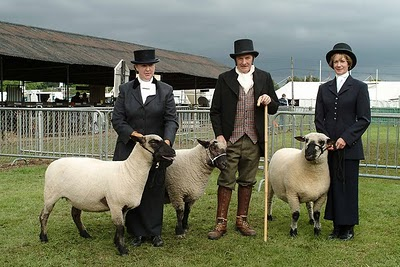- Juliana Santilli guest-blogs on the book Agrobiodiversity and the Law over at Agrobiodiversity Grapevine.
- ICARDA tells communities how to set up a sheep breeding programme.
- While an Indian institute breeds pigs, with Canadian help.
- Another Indian institute does the same for mushrooms, with no help.
- And yet another sequences the coconut genome.
- While BGI sequences a whole bunch of CIAT cassava stuff. Only yesterday they were doing rice. Yeah, but only 50, and you gotta keep those sequencers going, don’t you? Would be nice to know how much the CGIAR is paying BGI annually. Do they get frequent flyer miles? Have they negotiated a corporate rate?
- A Kazakhstan apple tree grows on the East River. A forest, actually. If it had been in England, it might eventually feature here. Ok, ok, our quest for connections is occasionally overdone. Made you look, though.
- Ah, kimchi! Ah, fish empanadas! So much interesting food, only one stomach lining…
- Danny tells us about Ireland’s CWR database. In other news, Ireland has CWR. Oh, and then he goes crazy on the Biodiversity for Nutrition mailing list. Did he get his goat is what I want to know.
- AoB on in vitro peach palms. Why read the paper, when AoB abstracts the abstract?
- Bifurcated Carrots on seed saving in Canada. Video goodness galore.
- And while we’re talking cinema, here’s news of a movie on a year in the life of four Kenyan farmers.
- From Kenyan farmers to First Farmers. The Womb of Nations. I like that. And more. Agricultural hearths. I like that too.
- Four days of discussion about land tenure. May not be enough, actually.
- “…70 per cent of the peppermint sold in the US is descended from a mutant in a neutron-irradiated source.” Good to know.
- I missed International Mountains Day. Again.
- That EU-funded taro mega-project from a PNG perspective.
- What I like about this Worldwatch series on neglected plants is that they’re not factsheets. Yet.
Climate-smart agriculture in Durban and around the world
Nibbles: Cannabis, Biochar, Hessian fly, Conference, Anti-conference, Mexican seeds
- Plant domain name changes hands for “high” price.
- Biochar reduces emissions of greenhouse gases from glacial soils. Probably cures dandruff too.
- We love resistance to wheat hessian fly, as an example of the value of agricultural biodiversity. Now it gets really interesting.
- 18th Annual International Sustainable Development Research Conference, University of Hull. h/t CAPRi Deadline for submissions is Thursday! Hurry!
- But wait! “‘Sustainable Development’ Is Often Used Gratuitously”.
- Local seed saving in Mexico.
Brainfood: Growth, Grasslands, Seaweed, Apple pedigrees, Marker assisted selection, Ants, Iron biofortification
- Economic growth and biodiversity. “There is no fundamental conflict between economic growth and biodiversity.” Hmmmmn.
- Phytodiversity of temperate permanent grasslands: ecosystem services for agriculture and livestock management for diversity conservation. At heart, a plea for more interdisciplinary research.
- The Interaction between Seaweed Farming as an Alternative Occupation and Fisher Numbers in the Central Philippines. Alternative occupations don’t necessarily reduce over-harvesting.
- Genotyping of pedigreed apple breeding material with a genome-covering set of SSRs: trueness-to-type of cultivars and their parentages. Your papa aint your papa but your papa don’t know.
- The GCP molecular marker toolkit, an instrument for use in breeding food security crops. Marker-assisted selection is not yet used for Musa spp., coconut, lentils, millets, pigeonpea, sweet potato, and yam. For the other 12 crops, 214 molecular markers were found to be effectively used in association with 74 different traits.
- Ant diversity and bio-indicators in land management of lac insect agroecosystem in Southwestern China. When you’re managing for a wild insect, the wild species are secondary.
- Biofortification for combating ‘hidden hunger’ for iron. Swings and roundabouts apply, with a vengeance.
How endangered are Shropshire sheep?

You may have seen stories in the past week or so of a flock of Shropshire sheep that authorities in Canada have threatened with destruction. The sheep belong to Montana Jones, who raises them at her Wholearth Farm, near Hastings in Peterborough. Five years ago she sold a ewe to a farmer in Alberta, and that sheep has been diagnosed with scrapie. As a result, the Canadian Food Inspection Agency wants to destroy other animals from the same flock who are infected or suspected of being infected.
One problem for Montana Jones is that the test “is only about 85% accurate”. So the sheep that tested positive may not have scrapie, although I have no idea what that 85% figure actually means. False positives? False negatives? What?
It is a long time since I last had to get my ahead around scrapie, the risks to humans (it is not “mad sheep disease”), the different breed susceptibilities, and the different approaches to eradication. All of those are important issues, I am sure. What concerns me about Montana Jones’ case is whether the appeal to the rarity of Shropshire sheep justifies not taking the precaution of slaughtering some of the flock.
Of course it is heart-breaking to lose animals you have lavished care on, especially when you feel that the action is not justified. But while Shropshires may be very rare in Canada, with all kinds of historical attachments, they are in pretty reasonable shape elsewhere, for example at their home in the UK. (Here is a wool nut’s view of the UK Rare Breeds Survival Trust’s rankings.) I wonder, too, how much genetic diversity the Canadian flocks represent. Wouldn’t it be cool if someone were able to genemap all the Shropshires around the world, in order to be able to show the CFIA just what we would be losing if they go ahead with their plan to cull half of Montana Jones’ flock?
By all means go ahead and sign the petition to save those Shropshires, but consider, too, that evidence of their genetic importance might just carry more weight.